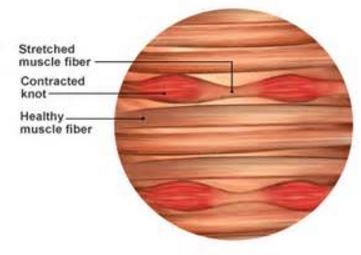Muscle Knots
What are Muscle Knots?
At certain points of the skeletal muscle, muscular fibers are unable to release their contracted mode. The elasticity of the muscle fibers is lost due to muscle knots development and impaired mobility and flexibility of the body become loose and stiffness is generated.

The development of the muscle knot can be felt by fingertips when you touch the particular location. In scientific language muscle knots is termed as Myofascial Trigger Points (MTPs). The sizes of the knots are varied, it may be a small pinhead sized or it may be large like thumb sized, depends on affected sites and reason of the development of the muscle knot.
Usually muscle knots formation is painful and it generates pain in two ways:
- Putting pressure on the knots causes pain for latent trigger points
- Pain is generated in non-localized areas due to generation of referred pain involving neural pathways and termed as active trigger point.
The excess metabolic waste accumulation due to constant contraction or hindered blood circulation carry pain signals to the central nervous system and muscle knots become painful. For stoppage of pain signals conveying, the CNS sends message to the particular muscle for relaxing. This causes muscle stiffness.

What Causes Muscle Knots?
Following are possible cause of development of the muscle knots:
- Acute traumatic injury: This includes falling down, accidental injury during sports activity which produces strain in the joints or surrounded muscular tissue
- Defective posture or stress generated due to prolonged posture: sudden strain generation due to improper lifting, sitting without support, maintain same posture for prolonged period.
- Over stress due to continuous activity: arduous activities including sports and exercise.
Treatment of muscle knots
Rest
Pain generation due to muscle knots can be eradicated by taking rest or restrict the repeated activity which generate pain in the muscle knots, such as prolonged sitting posture or arduous exercise or sports activity.
Massage
The myofacial release therapy is beneficial for treating and relaxing muscle knots. This therapy can be applied by therapists or self management is also possible. In this technique, gentle pressure helps to release the shortness or tightness of the muscular fibers. This treatment helps patients to restore the flexibility which may be defeated due to injury or day to day wear and tear of the tissue.
Self management techniques
Massage ball therapy can be applicable by own and one of the effective treatment for painful knot. In this technique, tennis ball or lacrosse ball can be used. To treat the muscle knot, massage ball is placed on the floor or wall and then lie down in such a manner that the affected muscle should keep on the ball. Then slowly pressure and roll over the ball. This helps to loosen the twisted muscle fibers and also improves the blood circulation.
Physical Therapy
Physical therapy also beneficial for treating muscle knots. Physical therapy including dry needling, Graston techniques provides effective results for some cases.
Stretching
The different stretching and exercise techniques help to relax the contracted muscle fibers. It is advisable not to conduct any type of physical exercise or stretching without taking advice from the therapist or trainer. Improper technique cannot reduce any pain, but it may increase the pain or provide harmful effect.
It is also advisable that a gentle mobility should always keep on for preventing immobility, and it also reduces the stiffness.
Medication
Pain medication is provided in case of severe pain. Non-steroidal- anti-inflammatory drugs, steroidal drugs like corticosteroids and Botox injection are also prescribed. To reduce the side effects, usually these drugs are given in low dose accompanied with physical therapies.
Prevention
‘Prevention is better than cure’. For preventing the muscle knots following steps can be applied:
- Balance diet and increase water intake can prevent muscle knots. Regular intake of caffeine or alcohol increase the chance of development of the muscle knots, as these increases the dehydration. Sufficient nutrition with plenty of water intake prevents muscle contraction during any type of physical strain.
- Instead of maintain same posture for prolonged time, frequently changing posture or taking break for short duration helps to prevent development of the muscle knots.
- Gentle physical exercise helps to maintain the muscle elasticity. Regular exercise prevents the sudden muscle contraction during stretching, fast movement or lifting heavy weight.
- Healthy life style: Wrong life style impacted also muscular health. Maintain healthy life style including adequate sleep, regular breathing exercise, and some recreation time atleast 15 minutes break can help to maintain the healthy body.
- Massage: When pain is generated then only application of massage helps to treat the muscle knots, but after regular interval spa or any massage therapy helps to maintain the proper elasticity, blood circulation, oxygen providence to all the body parts.
References
- http://www.builtlean.com/2012/06/07/muscle-knots/
- https://www.athletico.com/2014/05/01/what-is-a-muscle-knot/
- http://www.refinery29.com/2014/11/77415/muscle-knot-facts
